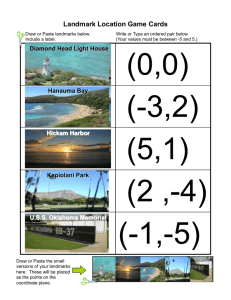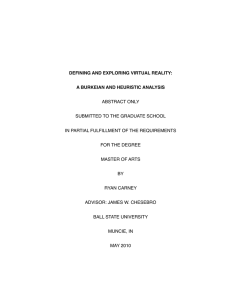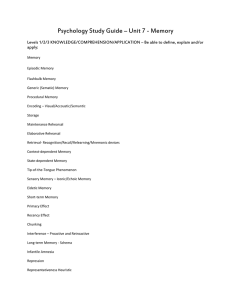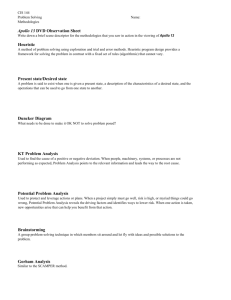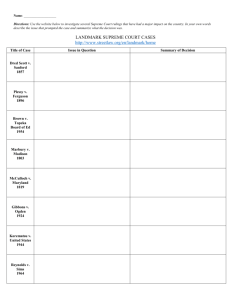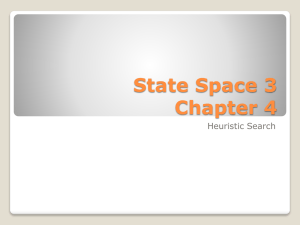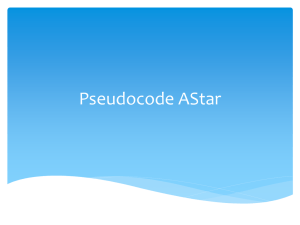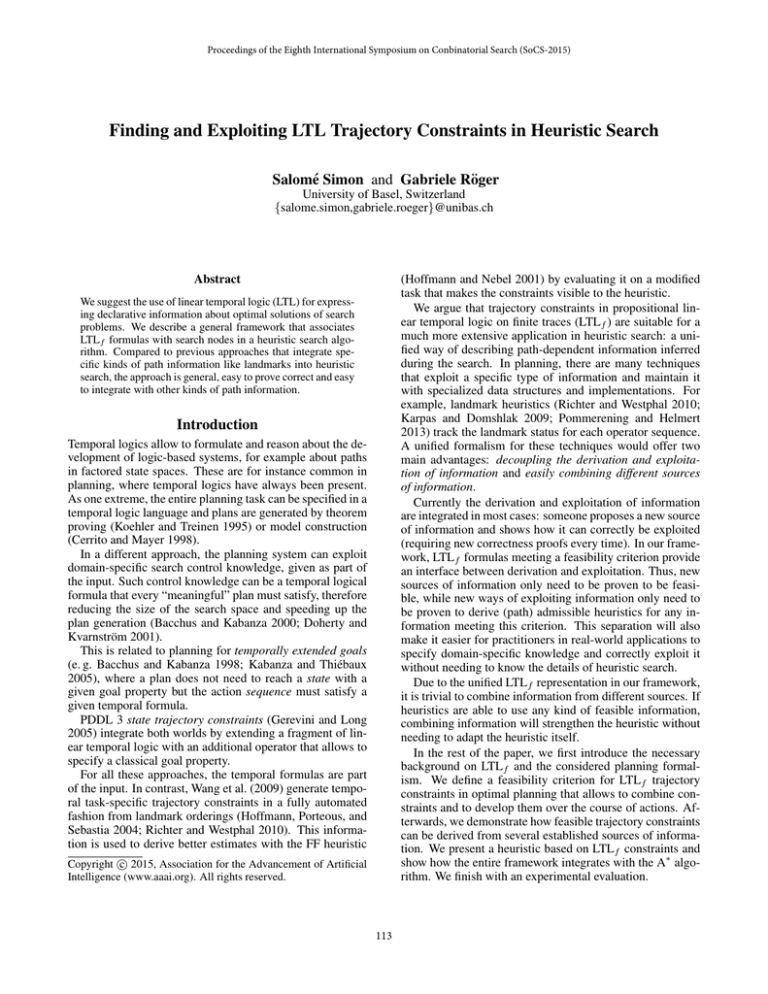
Proceedings of the Eighth International Symposium on Conbinatorial Search (SoCS-2015)
Finding and Exploiting LTL Trajectory Constraints in Heuristic Search
Salomé Simon and Gabriele Röger
University of Basel, Switzerland
{salome.simon,gabriele.roeger}@unibas.ch
Abstract
(Hoffmann and Nebel 2001) by evaluating it on a modified
task that makes the constraints visible to the heuristic.
We argue that trajectory constraints in propositional linear temporal logic on finite traces (LTLf ) are suitable for a
much more extensive application in heuristic search: a unified way of describing path-dependent information inferred
during the search. In planning, there are many techniques
that exploit a specific type of information and maintain it
with specialized data structures and implementations. For
example, landmark heuristics (Richter and Westphal 2010;
Karpas and Domshlak 2009; Pommerening and Helmert
2013) track the landmark status for each operator sequence.
A unified formalism for these techniques would offer two
main advantages: decoupling the derivation and exploitation of information and easily combining different sources
of information.
Currently the derivation and exploitation of information
are integrated in most cases: someone proposes a new source
of information and shows how it can correctly be exploited
(requiring new correctness proofs every time). In our framework, LTLf formulas meeting a feasibility criterion provide
an interface between derivation and exploitation. Thus, new
sources of information only need to be proven to be feasible, while new ways of exploiting information only need to
be proven to derive (path) admissible heuristics for any information meeting this criterion. This separation will also
make it easier for practitioners in real-world applications to
specify domain-specific knowledge and correctly exploit it
without needing to know the details of heuristic search.
Due to the unified LTLf representation in our framework,
it is trivial to combine information from different sources. If
heuristics are able to use any kind of feasible information,
combining information will strengthen the heuristic without
needing to adapt the heuristic itself.
In the rest of the paper, we first introduce the necessary
background on LTLf and the considered planning formalism. We define a feasibility criterion for LTLf trajectory
constraints in optimal planning that allows to combine constraints and to develop them over the course of actions. Afterwards, we demonstrate how feasible trajectory constraints
can be derived from several established sources of information. We present a heuristic based on LTLf constraints and
show how the entire framework integrates with the A∗ algorithm. We finish with an experimental evaluation.
We suggest the use of linear temporal logic (LTL) for expressing declarative information about optimal solutions of search
problems. We describe a general framework that associates
LTLf formulas with search nodes in a heuristic search algorithm. Compared to previous approaches that integrate specific kinds of path information like landmarks into heuristic
search, the approach is general, easy to prove correct and easy
to integrate with other kinds of path information.
Introduction
Temporal logics allow to formulate and reason about the development of logic-based systems, for example about paths
in factored state spaces. These are for instance common in
planning, where temporal logics have always been present.
As one extreme, the entire planning task can be specified in a
temporal logic language and plans are generated by theorem
proving (Koehler and Treinen 1995) or model construction
(Cerrito and Mayer 1998).
In a different approach, the planning system can exploit
domain-specific search control knowledge, given as part of
the input. Such control knowledge can be a temporal logical
formula that every “meaningful” plan must satisfy, therefore
reducing the size of the search space and speeding up the
plan generation (Bacchus and Kabanza 2000; Doherty and
Kvarnström 2001).
This is related to planning for temporally extended goals
(e. g. Bacchus and Kabanza 1998; Kabanza and Thiébaux
2005), where a plan does not need to reach a state with a
given goal property but the action sequence must satisfy a
given temporal formula.
PDDL 3 state trajectory constraints (Gerevini and Long
2005) integrate both worlds by extending a fragment of linear temporal logic with an additional operator that allows to
specify a classical goal property.
For all these approaches, the temporal formulas are part
of the input. In contrast, Wang et al. (2009) generate temporal task-specific trajectory constraints in a fully automated
fashion from landmark orderings (Hoffmann, Porteous, and
Sebastia 2004; Richter and Westphal 2010). This information is used to derive better estimates with the FF heuristic
c 2015, Association for the Advancement of Artificial
Copyright Intelligence (www.aaai.org). All rights reserved.
113
Background
ϕ
p ∈ P:
¬ψ:
ψ ∧ ψ0 :
ψ ∨ ψ0 :
dψ:
ψ:
♦ψ:
ψUψ 0 :
ψRψ 0 :
last:
>:
⊥:
In linear temporal logic (LTL, Pnueli 1977) a world w over a
set P of propositional symbols is represented as set w ⊆ P
of the symbols that are true in w. LTL extends propositional
logic (with operators ¬ and ∧) with a unary operator d and a
binary operator U, which allow to formulate statements over
infinite sequences of such worlds. Intuitively, dϕ means that
ϕ is true in the next world in the sequence, and ϕUψ means
that in some future world ψ is true and until then ϕ is true.
In addition, we use the following common abbreviations:
• Standard abbreviations of propositional logic such as ∨
(or), → (implies), > (true), ⊥ (false)
• ♦ϕ = >Uϕ expresses that ϕ will eventually be true.
• ϕ = ¬♦¬ϕ expresses that from the current world on, ϕ
will always be true.
Figure 1: Progression Rules
• ϕRψ = ¬(¬ϕU¬ψ) expresses that ψ holds until ϕ holds
as well (releasing ψ) or forever.1
For an example, consider formula ϕ = dx ∧ ♦z over
P = {x, y, z} stating that in the following world proposition x should be true and at some point z should be true.
The progression of ϕ with a world w = {x, z} is
progress( dx ∧ ♦z, w) = progress( dx, w) ∧
LTL on finite traces (LTLf , De Giacomo and Vardi 2013;
De Giacomo, De Masellis, and Montali 2014) defines semantics for finite world sequences, using the additional abbreviation last = ¬ d>, which is true exactly in the last
world of the sequence.
progress(♦z, w)
= x ∧ (progress(z, w) ∨ ♦z)
= x ∧ (> ∨ ♦z) ≡ x
Definition 1 (Semantics of LTLf ). Let ϕ be an LTLf formula over a set of propositional symbols P and let w =
hw0 , . . . , wn i be a sequence of worlds over P.
For 0 ≤ i ≤ n, we inductively define when ϕ is true at
instant i (written w, i |= ϕ) as:
•
•
•
•
•
progress(ϕ, w)
> if p ∈ w, ⊥ otherwise
¬progress(ψ, w)
progress(ψ, w) ∧ progress(ψ 0 , w)
progress(ψ, w) ∨ progress(ψ 0 , w)
ψ
progress(ψ, w) ∧ ψ
progress(ψ, w) ∨ ♦ψ
progress(ψ 0 , w) ∨ (progress(ψ, w) ∧ (ψUψ 0 ))
progress(ψ 0 , w) ∧ (progress(ψ, w) ∨ (ψRψ 0 ))
⊥
>
⊥
The progression eliminates the ♦z from the formula because it is already satisfied with w. Subformula dx gets replaced with x, which fits the requirement that x should now
be true if ϕ is satisfied by the overall world sequence.
In the special case where a progression results to ⊥ (or
>), it is clear that no (or any) continuation will result in an
overall world sequence that satisfies the original formula.
For p ∈ P, w, i |= p iff p ∈ w0
w, i |= ¬ψ iff w, i 6|= ψ
w, i |= ψ1 ∧ ψ2 iff w, i |= ψ1 and w, i |= ψ2
w, i |= dψ iff i < n and w, i + 1 |= ψ
w, i |= ψ1 Uψ2 iff there exists a j with i ≤ j ≤ n s.t.
w, j |= ψ2 and for all i ≤ k < j, w, k |= ψ1
We consider search problems given as STRIPS planning
tasks with action costs. Such a planning task is a tuple Π = hV, A, I, Gi, where V is a set of propositional
state variables, A is a set of actions, I ⊆ V is the initial state and G ⊆ V is the goal description. An action
a = hpre(a), add (a), del (a), c(a)i ∈ A consists of the precondition pre(a) ⊆ V , the add effects add (a) ⊆ V , the
delete effects del (a) ⊆ V and the action cost c(a) ∈ R+
0. A
state s ⊆ V is defined by a subset of the variables. Action a
is applicable in state s if pre(a) ⊆ s. Applying a in s leads
to the successor state s[a] = (s \ del(a)) ∪ add(a). A path is
a sequence of actions π = ha1 , . . . , an i and is applicable in
state s if the actions are applicable consecutively. We denote
the resulting state with s[ha1 , . . . , an i]. For the
Pnempty path,
s[hi] = s. The cost of the path is c(π) = i=1 c(ai ). A
plan is a path π such that G ⊆ I[π]. It is optimal if it has
minimal cost.
We will formulate LTLf trajectory constraints that do not
only cover state variables but also action applications. We
follow the approach by Calvanese, De Giacomo, and Vardi
(2002) and introduce an additional variable a for each action
of the planning task. Therefore, the set P comprises these
action variables plus the state variables of the planning task.
If w, 0 |= ϕ, we say that ϕ is true in w or that w satisfies
ϕ and also write this as w |= ϕ.
In our application, we do not only want to reason about
finalized world sequences but also about possible continuations of given prefixes. Bacchus and Kabanza (2000)
showed for standard LTL with infinite world sequences how
we can evaluate formulas progressively over the beginning
hw0 , . . . , wi i of a world sequence. The idea is to create a formula which is satisfied by arbitrary continuations
hwi+1 , wi+2 , . . . i iff the original formula is satisfied by the
entire sequence hw0 , . . . , wi , wi+1 , . . . i. As long as we do
not progress over the last world in the sequence, the progression rules (shown in Figure 1) also work for LTLf :
Proposition 1. For an LTLf formula ϕ and a world
sequence hw0 , . . . , wn i with n > 0 it holds that
hw1 , . . . , wn i |= progress(ϕ, w0 ) iff hw0 , . . . , wn i |= ϕ.
1
While R can be expressed in terms of the essential operators, it
is necessary for the positive normal form, which we will introduce
and use later.
114
For the concatenation of two finite sequences σ and σ 0 ,
0
we write σσ 0 . For example, hw1 , . . . , wn ihw10 , . . . , wm
i=
0
0
hw1 , . . . , wn , w1 , . . . , wm i. We use this notation for action
and world sequences.
nodes with identical state is desirable. Instead of only keeping the formula of the preserved node, we can exploit the
information of two paths of equal cost by combining the two
feasible formulas:
Theorem 2. Let n and n0 be two search nodes such that
g(n) = g(n0 ) and s(n) = s(n0 ). Let further ϕn and ϕn0 be
feasible for the respective node. Then ϕn ∧ ϕn0 is feasible
for both n and n0 .
Feasible LTLf Formulas for Optimal Planning
Graph search algorithms like A∗ operate on search nodes n
that associate a state s(n) with a path of cost g(n) from the
initial state I to this state. We want to associate search nodes
with LTLf trajectory constraints that characterize how the
path to the node should be continued. This information can
then be exploited for deriving heuristic estimates.
Such per node LTLf constraints are suitable for optimal planning if they are satisfied by any continuation of
the path to the node into an optimal plan. To capture
this notion, we define the world sequence induced by path
ρ = ha1 , . . . , an i in state s as wρs = h{a1 } ∪ s[a1 ], {a2 } ∪
s[ha1 , a2 i], . . . , {an } ∪ s[ρ], s[ρ]i and introduce the following feasibility criterion:
Proof sketch. Whether a formula is feasible for a node only
depends on the set of relevant paths characterized in Definition 2. The node only influences this characterization with
its g-value and its associated state s. Therefore, a formula is
either feasible for all nodes that agree on these components
or for none of them. Feasibility of the conjunction follows
directly from the LTLf semantics.
Definition 2 (Feasibility for nodes). Let Π be a planning
task with goal G and optimal plan cost h∗ and let n be a
node in the search space that is associated with state s.
An LTLf formula ϕ is feasible for n if for all paths ρ such
that
Feasible formulas for a node only talk about the future but
do not cover the current state. This can lead to an needlessly
complicated specification of information that is derived before starting the search. For example, the notion of landmarks is defined for the entire state sequence traversed by
a plan – including the initial state. We therefore also introduce feasibility for tasks that allows to naturally formulate
information about this entire state sequence.
• ρ is applicable in s,
• the application of ρ leads to a goal state (G ⊆ s[ρ]), and
• g(n) + c(ρ) = h∗
Definition 3 (Feasibility for tasks). Let Π be a planning
task with initial state I. An LTLf formula ϕ is feasible for
I
∗
Π if hIiwπ
∗ |= ϕ for all optimal plans π .
it holds that wρs |= ϕ.
Progressing a feasible formula for a task with its initial
state yields a feasible formula for the initial search node.
If the path to node n is not a prefix of an optimal plan,
then any formula is feasible for n. Otherwise, ϕ must be
true for any continuation of the path into an optimal plan but
not necessarily for continuations into suboptimal plans.
If a formula is feasible for a node, its progression is feasible for the corresponding successor node.
Finding Feasible LTLf Trajectory Constraints
In this section we will demonstrate how existing examples
from the literature can be used to derive feasible LTLf trajectory constraints. We will present details for landmarks
and unjustified action applications. To give an intuition for
the scope of the framework, we will also briefly comment
on further possibilities.
Theorem 1. Let ϕ be a feasible formula for a node n, and
let n0 be the successor node reached from n with action a.
Then progress(ϕ, {a} ∪ s(n0 )) is feasible for n0 .
Fact Landmarks and Landmark Orderings
Proof. Let Ra be the set of paths that continue the history
of n to an optimal plan (and are therefore relevant for the
feasibility of ϕ) and in addition begin with action a. If Ra
is empty, the path leading to n0 cannot be continued to an
optimal plan and therefore any formula is feasible for n0 .
Otherwise let ρ0 be a path that continues the path to n0 to an
optimal plan. Then ρ = haiρ0 is in Ra and wρs(n) |= ϕ.
s(n0 )
Since wρs(n) = h{a} ∪ s(n0 )iwρ0
that
s(n0 )
wρ0
A (fact) landmark (Hoffmann, Porteous, and Sebastia 2004)
is a state variable that must be true at some point in every
plan. A landmark ordering specifies that before a landmark
becomes true some other landmark must have been true.
There are several methods in the literature to extract
such landmark information for a given planning task (Zhu
and Givan 2003; Hoffmann, Porteous, and Sebastia 2004;
Richter and Westphal 2010; Keyder, Richter, and Helmert
2010).
Wang, Baier, and McIlraith (2009) already encoded landmark orderings in LTL. Since in our scenario, progression
notices when a landmark has been reached, we can use a
slightly more compact formalization.
We base our definitions of landmarks and landmark orderings on the notions by Richter and Westphal (2010).
A state variable p is a (fact) landmark of a planning task
Π if the application of every plan π of Π visits some state
, Proposition 1 implies
|= progress(ϕ, {a} ∪ s(n0 )).
We also have the opportunity to incorporate additional
feasible trajectory constraints: if we can derive a new feasible formula ϕnew for a node, we can safely combine it
with the progressed formula ϕprogress to a feasible formula
ϕprogress ∧ ϕnew .
Since graph search algorithms eliminate nodes with duplicate states, a strategy for combining feasible formulas from
115
The subformula ϕlm ∧ ϕra ∧ ϕgoal also provides an alternative way of computing the inadmissible landmark count
heuristic, which can only be used for planning without optimality guarantee: We determine this task-feasible formula
from the same precomputation as performed by the landmark count heuristic and progress it in our framework. The
heuristic estimate for a node can then be determined from
the associated feasible formula as the cardinality of the set
of all state variables that occur within a ♦ formula but are
false in the state of the node.
that contains p. Therefore, ♦p is a feasible formula for the
task if p is a landmark.
There are three types of sound landmark orderings.
A natural ordering l →nat l0 states that if l0 becomes true
for the first time at time step i, then l must be true at some
time step j < i. This can be expressed as ¬l0 U(l ∧ ¬l0 )
because l0 can only become true after l was true.
A greedy-necessary ordering l →gn l0 states that if l0 becomes true for the first time at step i, then l must be true at
time step i − 1. This can be formulated as ¬l0 U(l ∧ ¬l0 ∧ dl0 )
because l must be true directly before l0 becomes true for the
first time.
A necessary ordering l →nec l0 states that for each time
step i where l0 becomes true, l must be true at time step
i − 1. Put differently, whenever l0 becomes true in the next
step, then currently l must be true: (¬l0 ∧ dl0 → l).
There are important other landmark-related notions for
which we are not aware of any previous LTL encodings.
One such relevant source of information are the first
achievers of a landmark. A first achiever set FAl for a landmark l is a set of actions such that in any plan one of these
actions makes the landmark true W
for the first time. For a first
achiever set FAl the formula l ∨ a∈FAl ♦a describes that if
the landmark is not initially true, then one of the actions in
the set needs to be applied.
The landmark count heuristic (Richter and Westphal
2010) counts how many landmarks have not yet been
reached (i. e., they have not been true on the path to the
node) and how many reached landmarks are required again.
A reached landmark l is required again if l is false in the
current state and there is a greedy-necessary (or necessary)
ordering l → l0 where l0 has not yet been reached. Additionally, any reached landmark l that is a goal proposition and
false in the current state is required again.
We can formulate these conditions for required again
0
landmarks as (♦l)Ul
orderings l →gn
V for greedy-necessary
0
l and as (♦g)U g0 ∈G g 0 for goal landmarks g and goal
specification G.
All these formulas can be combined into a single LTLf
formula that is feasible for the task:
Proposition 2. For planning task Π with goal G, let L be a
set of landmarks and let Onat , Ogn , and Onec be sets of natural, greedy-necessary and necessary landmark orderings,
respectively. Let FA be a set of first achiever sets for landmarks. The following formula ϕ is feasible for Π.
Action Landmarks
A (disjunctive) action landmark is a set of actions of which
at least one must occur in any plan.
a set of action landmarks for state s0 then ϕL =
V If L is W
0
L∈L ♦( a∈L a) is feasible for all nodes n with s(n) = s .
One example for an action landmark is the set of first
achievers for a landmark that is currently not true. Also the
LM-Cut heuristic (Helmert and Domshlak 2009) derives a
set of action landmarks as a byproduct of the heuristic computation. The incremental LM-Cut heuristic (Pommerening
and Helmert 2013) stores and progresses this set to speed up
the LM-Cut computation for the successor states. At the application of an action a, incremental LM-Cut creates a new
landmark set for the successor state by removing all action
landmarks that contain a. Let L and L0 be the respective
landmark sets before and after the action application. The
progression of ϕL over a is logically equivalent to ϕL0 , so
LTLf progression reflects the landmark-specific progression
by incremental LM-Cut.
Unjustified Action Applications
The key idea behind unjustified action applications (Karpas
and Domshlak 2011; 2012) is that every action that occurs in
a plan should contribute to the outcome of the plan – by enabling another action in the plan or by making a goal proposition finally true.
The definition is based on the notion of causal links: a
path ρ = ha1 , . . . , an i has a causal link between the i-th and
the j-th action application if i < j, ai adds a proposition p
which stays true and is not added again until step j − 1, and
p is a precondition of aj . If there is a link between the i-th
and a later action application in a plan π or the i-th action
adds a goal proposition that is not added again later, then the
i-th action application is justified, otherwise it is unjustified.
A plan π with an unjustified application of a positive-cost
action a cannot be optimal because removing this action application from π results in a cheaper plan π 0 .
The notion of unjustified action applications is defined
for entire plans but during search the question is whether
the current path can be extended to a plan without unjustified action applications and how we can characterize such an
extension. The relevant information can easily be encoded
within the LTLf framework: if the last action application is
justified, at least one of the add effects must stay true and
cannot be added again until it is used as a precondition or
for satisfying the goal. Since we want to preserve all optimal plans, we do not exploit this information for zero-cost
actions.
ϕ = ϕlm ∧ ϕfa ∧ ϕnat ∧ ϕgn ∧ ϕnec ∧ ϕra ∧ ϕgoal
where
V
• ϕlm = l∈L ♦l
V
W
• ϕfa = FAl ∈FA l ∨ a∈FAl ♦a
V
• ϕnat = l→nat l0 ∈Onat ¬l0 U(l ∧ ¬l0 )
V
• ϕgn = l→gn l0 ∈Ogn ¬l0 U(l ∧ ¬l0 ∧ dl0 )
V
• ϕnec = l→nec l0 ∈Onec (¬l0 ∧ dl0 → l)
V
• ϕra = l→l0 ∈Ogn ∪Onec (♦l)Ul0
V
V
• ϕgoal = g∈G (♦g)U g0 ∈G g 0
116
Theorem 3. Let Π = hV, A, I, Gi be a planning task and
let n be a search node that was reached with a positive-cost
action a. Then the following formula ϕa is feasible for n:
_
^
_ ϕa =
(e ∧ ¬a0 )U
a0 ∨
e∈add(a)\G
_
e∈add(a)∩G
and later apply an action requiring p, we in between have to
apply an action adding p.
In principle, we could go as far as encoding the entire
planning task in the LTL formula (Cerrito and Mayer 1998).
The challenge with the framework will be to find a suitable
balance of the incurred overhead and the gain in heuristic
information.
a0 ∈A with a0 ∈A with
e∈add(a0 ) e∈pre(a0 )
(e ∧
^
¬a0 )U last ∨
a0 ∈A with
e∈add(a0 )
_ a0
Deriving Heuristic Estimates from Feasible
LTLf Trajectory Constraints
a0 ∈A with
e∈pre(a0 )
Deriving heuristic estimates from feasible LTLf trajectory
constraints is an interesting research question, which cannot finally be answered in this paper. For the moment, we
only present a proof-of-concept heuristic that extracts landmarks, essentially ignoring the temporal information carried
by the LTLf formula. However, the temporal aspects of the
LTLf formulas are still important for the heuristic estimate
because they preserve information over the course of progression. In the future we also want to investigate methods
that are based on LTL reasoning and which are therefore able
to derive stronger estimates from the temporal information.
Although we extract landmarks from the input LTLf formula, this does not mean that this LTLf formula must stem
from landmark information. The heuristic is correct for any
kind of feasible LTLf formulas.
The heuristic computation first derives so-called nodeadmissible disjunctive action landmarks from the LTLf
formula. The heuristic estimate is then determined from
these landmarks with the landmark heuristic by Karpas and
Domshlak (2009).
As introduced earlier, a disjunctive action landmark for a
state s is a set of actions such that every path from s to a
goal state contains at least one action from the set. We use a
weaker path-dependent notion that covers all optimal plans:
Definition 4. Let Π = hV, A, I, Gi be a planning task and
n be a search node. A set L ⊆ A is a node-admissible disjunctive action landmark for n if every continuation of the
path to n into an optimal plan contains an action from L.
Using such node-admissible disjunctive action landmarks
in the landmark heuristic gives admissible estimates for all
nodes that correspond to a prefix of an optimal plan. Karpas
and Domshlak (2012) call this property path admissible.
Our method of extracting node-admissible landmarks
from LTLf formulas requires the formula to be in positive
normal form (also called negation normal form), where ¬
only appears in literals or before last. This is uncritical because any LTLf formula can efficiently be transformed into
positive normal form with De Morgan’s law and the following equivalences:
¬ dϕ ≡ last ∨ d¬ϕ
¬ϕ ≡ ♦¬ϕ
¬(ϕ1 Uϕ2 ) ≡ (¬ϕ1 )R(¬ϕ2 )
¬♦ϕ ≡ ¬ϕ
¬(ϕ1 Rϕ2 ) ≡ (¬ϕ1 )U(¬ϕ2 )
Moreover, progression preserves the normal form.
For the landmark extraction from the feasible formula, we
first derive an implied LTLf formula (Proposition 3) in conjunctive normal form. We then extract node-admissible disjunctive action landmarks from its clauses (Theorem 4).
Proof sketch. Let ρ denote the path that lead to n. Assume
that ϕa is not feasible for n, so there is a path ρ0 that satisfies
s(n)
the conditions from Definition 2 but wρ0 6|= ϕa . Then ρ0
does not use any add effect of a before it gets deleted or
added again by another action application. Also each goal
atom added by a is deleted or added again by ρ0 . Therefore
the application of a in the plan ρρ0 is unjustified. As c(a) >
0 there exists a cheaper plan and g(n)+c(ρ0 ) cannot be equal
to the optimal plan cost of Π. This is a contradiction to ρ0
satisfying the conditions from Definition 2.
The original implementation of unjustified action applications requires an analysis of the causal links and resulting
causal chains of the action sequence. All information required for this reasoning is encoded in the LTLf formulas
and standard LTLf progression replaces this analysis of the
causal interactions.
We could even go further: Instead of adding a feasible
formula ϕa after each application of action a, we could also
extend the
V feasible formula for the initial node with a conjunction a∈A a → dϕa , ranging over the set of all actions
A, and let the progression do the rest. However, since planning tasks can have thousands of actions, this would lead to
significant overhead in the progression.
Other Sources of Information
The scope of our approach is by far not limited to the previously introduced sources of information. Since space is
limited, we only briefly mention some other ideas.
One obvious possibility is the integration of previous LTL
methods like hand-written (Bacchus and Kabanza 2000;
Doherty and Kvarnström 2001) or learned (de la Rosa and
McIlraith 2011) LTL search control knowledge.
Also invariants such as mutex information can be added
to the LTLf formula to make them explicit to the heuristic
computation. The same holds for
V the fact that at the end the
goal G must be true (♦(last ∧ g∈G g)).
The recent flow-based heuristics (van den Briel et al.
2007; Bonet 2013; Pommerening et al. 2014) build on the
observation that a variable cannot be (truly) deleted more
often than it is made true (with some special cases for the
initial state and the goal) but they ignore the order of the corresponding action applications. With LTLf formulas we can
express statements of the same flavor but preserving parts of
the ordering information. For an intuition, consider a formula that states that whenever we apply an action deleting p
117
A∗ with LTLf Trajectory Constraints
Proposition 3. Let ϕ be an LTLf trajectory constraint in
negation normal form. The following function lm defines an
LTLf formula such that ϕ |= lm(ϕ):
Since LTLf trajectory constraints are path-dependent and
the heuristic is not admissible but only path admissible, we
need to adapt the A∗ algorithm so that it still guarantees optimal plans. This is only a small modification: whenever a
cheaper path to a state has been found, we need to recompute the heuristic estimate with the new feasible information
instead of using a cached estimate (Karpas and Domshlak
2012). This leads to a different treatment of infinite heuristic
estimates. We also use the opportunity to show the integration of feasible LTLf formulas.
Algorithm 1 shows the adapted A∗ algorithm. We formulated the algorithm with “eager” duplicate elimination so
that there is always at most one node for each state. Besides the planning task, the algorithm takes a path admissible heuristic function as input that computes the estimate
from a state and an LTLf formula.
We use a method taskFeasibleFormula(Π) that returns a
feasible formula for Π, and a method feasibleFormula(Π, π)
that generates a (path-dependent) feasible formula for the
node reached by path π.
The feasible formula for the task (line 3) is progressed
with the initial state to receive a feasible formula ϕ for the
initial search node, which can be further strenghened with
any other feasible formula for this node (line 4). If the
heuristic for the initial state and this formula is ∞ then the
task is unsolvable. Otherwise, we create the initial node and
add it to the open list (lines 6–8).
When generating the successor n0 of node n with action a,
we first progress the LTLf formula of n to get a new feasible
formula for n0 , based on Theorem 1 (line 17). Based on
Theorem 2, this formula can be strengthened with a newly
derived LTLf formula that is feasible for this node (line 18).
If we do not want to incorporate additional information, the
method can simply return >.
If we encounter the successor state for the first time, we
create a new node n0 with the respective properties (line 21).
Otherwise, we distinguish three cases for the previously best
node for this state. If we already found a better path to this
state, we skip this successor (line 24). If we previously
found an equally good path to the state, we strengthen the
LTLf formula of the previous node based on Theorem 2 and
recompute the heuristic estimate (lines 26–28). If the previously best path to the state was worse, we update the node
with the data from the newly found path (lines 30–33).
In contrast to an admissible heuristic, with a path admissible heuristic it is not safe to prune a state from the search
space if the heuristic estimate via one path (of cost g 0 ) is ∞.
However, we can conclude that no optimal plan traverses the
state with a cost of at least g 0 . To exploit this pruning power
for nodes encountered later, we do not discard a node with
infinite heuristic estimate but store it in the closed list (lines
35–36). If the node has a finite estimate, it gets enqueued in
the open list (line 38).
lm(x) = ♦x for literals x
lm(last) = ♦last
lm(¬last) = ♦¬last
lm(ϕ ∧ ψ) = lm(ϕ) ∧ lm(ψ)
lm(ϕ ∨ ψ) = lm(ϕ) ∨ lm(ψ)
lm( dϕ) = lm(ϕ) = lm(♦ϕ) = lm(ϕ)
lm(ϕUψ) = lm(ϕRψ) = lm(ψ)
The proposition can easily be checked from the semantics of LTLf . By distributing ∨ over ∧, we can transform W
the formula into conjunctive normal form (CNF)
V
n
mi
i=1 j=1 ♦ϕi,j , where each ϕi,j is a literal, last, or ¬last.
Clauses containing ♦last are tautologies and therefore not
valuable for the heuristic. Clauses containing ♦¬last are
trivially true for each world sequence of length at least two,
which is the case for the induced world sequences for any
path leading from a non-goal state to a goal state. Therefore, we derive the action landmarks only from the remaining clauses.
Theorem 4. Let Π = hV, A, I, Gi be a planning task and
let ϕ be a feasible
Wm LTLf trajectory constraint for node n. Let
further ψ = j=1 ♦xj (with xj being literals) be a formula
such that ϕ |= ψ.
Sm
If progress(ψ, s(n)) 6≡ >, then L = j=1 support(xj )
with
{a ∈ A | x ∈ add (a)} if x ∈ V
support(x) = {a ∈ A | x ∈ del (a)}
if x̄ ∈ V
{x}
if x ∈ A
is a node-admissible disjunctive action landmark for n.
Proof. Since ϕ |= ψ, ψ also is feasible for n. By the semantics of ♦, at least one xj must be true in some world in
any continuation to an optimal plan. If the progression is not
valid, then no state-variable literal xj is already true in the
current state.2 Thus, one of the xj needs to become true in
any optimal plan. For a proposition p, this means that p must
be added by an action. Similarly, for a negated proposition
¬p, the proposition p must be deleted. An action variable a
requires the action to be applied. Therefore, any continuation of the path to n into an optimal plan contains an action
from L.
Our proposed heuristic is the landmark heuristic computed from all node-admissible disjunctive action landmarks
that can be derived from the trajectory constraints as described in Proposition 3 and Theorem 4. In the special case
where the LTLf formula is detected unsatisfiable (simplifies
to ⊥), the heuristic returns ∞ because the path to the node
cannot be extended into an optimal plan.
Experimental Evaluation
2
Moreover, none of the xj is a negated action variable. Although these would not prevent the clause from generating an action landmark, the landmark would be very weak.
For the experimental evaluation, we implemented the LTLf
framework on top of Fast Downward (Helmert 2006). We
118
conducted all experiments with a memory limit of 4 GB
and a time limit of 30 minutes (excluding Fast Downward’s
translation and preprocessing phase).
Our heuristic derives disjunctive action landmarks from
LTLf constraints as input for the admissible landmark
heuristic (Karpas and Domshlak 2009). To evaluate the
overhead of our approach, we compare it to the standard
implementation of the landmark heuristic with specialized
data structures exploiting the same (initial) landmark information. In both cases, the landmark heuristic applies optimal cost-partitioning for computing the estimate.
For the landmark generation, we use the same approach as
the BJOLP planner (Domshlak et al. 2011), combining landmark information from two generation methods (Richter and
Westphal 2010; Keyder, Richter, and Helmert 2010).
For the LTLf approach, we generate an initial feasible
LTLf formula from the first achiever and the required again
formulas (corresponding to ϕfa , ϕra , and ϕgoal in Proposition 2) for these landmarks. We do not use the landmark and
ordering formulas because they would not additionally contribute to the heuristic estimates. We use this LTLf formula
as shown in Algorithm 1, not incorporating additional information in line 18. In the following, we refer to this setup as
LTL-A∗ with hLM
AL .
A meaningful application of the standard implementation of the landmark heuristic requires the search algorithm
LM-A∗ (Karpas and Domshlak 2009) that extends A∗ with
multi-path support for landmarks. We refer to this setup as
LM-A∗ with hLA .
The comparison of these two approaches is not entirely
fair because LM-A∗ combines information from all paths to
a state while LTL-A∗ only combines formulas from equally
expensive paths. Thus, with a comparable search history,
LM-A∗ can sometimes derive better heuristic estimates.
Table 1 shows results for the STRIPS benchmarks of the
International Planning Competitions 1998–2011.
Overall, LM-A∗ with hLA solves 723 tasks and LTL-A∗
with hLM
AL finds solutions for 711 tasks. All unsolved instances of the former are due to the time limit. With the
LTLf implementation 11 instances fail due to the memory
limit with 9 of them being airport instances.
To get a clearer idea of the memory overhead of the approach, we summed up the memory consumption of all commonly solved instances of each domain. The percentage in
parentheses shows the fraction of these two values where
numbers above 100% indicate that the LTLf approach required more memory. A positive surprise is that more often
than not our approach requires less memory. However, there
are also cases, where the increase in memory consumption
is significant, for example in the logistics-00 domain where
the LTLf implementation needs more than three times the
amount of the specialized implementation. This result is
not caused by the unfavorable comparison of the approaches
because the expansion numbers in both cases are identical.
Nevertheless, the memory consumption only is responsible
for a single unsolved task in this domain because 7 of the 8
affected instances fail due to a timeout.
Algorithm 1: A∗ with LTLf trajectory constraints
input : Planning task Π = hV, A, I, Gi and
path-admissible heuristic function h
output: Optimal plan π or unsolvable if Π is unsolvable
1
2
3
4
5
6
7
8
9
10
11
12
13
14
15
16
17
18
19
20
21
22
23
24
25
26
27
28
29
30
31
32
33
34
35
36
37
38
39
40
41
42
open ← empty priority queue of nodes
closed ← ∅
ϕΠ ← taskFeasibleFormula(Π)
ϕ ← progress(ϕΠ , I) ∧ feasibleFormula(Π, hi)
hval ← h(I, ϕ)
if hval 6= ∞ then
n ← new node with n.state = I, n.g = 0,
n.h = hval, n.ϕ = ϕ and n.parent = ⊥
add n to open with priority hval
while open is not empty do
n ← remove min from open
s ← n.state
if s is goal state then
return extractPlan(n)
add n to closed
for all actions a applicable in s do
s0 ← s[a]
ϕ0 ← progress(n.ϕ, {a} ∪ s0 )
ϕ0 ← ϕ0 ∧ feasibleFormula(Π, path to s0 via n)
g 0 ← n.g + c(a)
if there exists no node n0 with n0 .state = s0 then
n0 ← new node with n0 .state = s0 ,
n0 .g = g 0 , n0 .h = h(s0 , ϕ0 ),
n0 .ϕ = ϕ0 and n0 .parent = n
else
n0 ← unique node in open or closed with
n0 .state = s0
if g 0 > n0 .g then continue
remove n0 from open /closed
if g 0 = n0 .g then
n0 .ϕ ← n0 .ϕ ∧ ϕ0
n0 .h ← h(s0 , n0 .ϕ)
else
n0 .ϕ ← ϕ0
n0 .g ← g 0
n0 .h ← h(s0 , ϕ0 )
n0 .parent ← n
end
if n0 .h = ∞ then
add n0 to closed
else
add n0 to open with priority n0 .g + n0 .h
end
end
end
return unsolvable
119
airport (50)
barman (20)
blocks (35)
depot (22)
driverlog (20)
elevators-08 (30)
elevators-11 (20)
floortile (20)
freecell (80)
grid (5)
gripper (20)
logistics-00 (28)
logistics-98 (35)
miconic (150)
mprime (35)
mystery (30)
nomystery (20)
openstacks-08 (30)
openstacks-11 (20)
openstacks (30)
parcprinter-08 (30)
parcprinter-11 (20)
parking (20)
pathways (30)
pegsol-08 (30)
pegsol-11 (20)
pipesworld-notan (50)
pipesworld-tan (50)
psr-small (50)
rovers (40)
satellite (36)
scanalyzer-08 (30)
scanalyzer-11 (20)
sokoban-08 (30)
sokoban-11 (20)
tidybot (20)
tpp (30)
transport-08 (30)
transport-11 (20)
trucks (30)
visitall (20)
woodworking-08 (30)
woodworking-11 (20)
zenotravel (20)
Sum (1396)
LTL-A∗
hLM
AL
31 28 (335%)
0
0 (−%)
26 26 (107%)
7
7 (86%)
14 14 (88%)
14 14 (78%)
11 11 (77%)
2
2 (95%)
52 51 (123%)
2
2 (108%)
6
6 (187%)
20 20 (327%)
5
5 (99%)
141 141 (116%)
19 19 (90%)
15 15 (83%)
18 17 (147%)
14 12 (200%)
9
7 (229%)
7
7 (107%)
15 14 (149%)
11 10 (152%)
1
1 (121%)
4
4 (98%)
26 26 (155%)
16 16 (174%)
17 17 (91%)
9 10 (98%)
49 49 (87%)
7
7 (91%)
7
7 (86%)
10
9 (111%)
6
6 (114%)
22 21 (76%)
18 18 (76%)
14 14 (103%)
6
6 (95%)
11 11 (90%)
6
6 (86%)
7
7 (82%)
16 16 (136%)
14 14 (80%)
9
9 (78%)
9
9 (93%)
723 711
unsolved
106
hLM+UAA
AL
105
26
0
26
7
14
13
11
4
50
2
6
20
5
141
20
15
16
12
7
7
14
10
1
4
26
16
17
10
49
7
7
9
6
22
18
13
6
11
6
7
16
14
9
9
709
hLM+UAA
AL
LM-A∗
hLA
104
103
102
101
100
100 101 102 103 104 105 106 uns.
hLM
AL
Figure 2: Comparison of expansions.
In a second experiment, we include in addition feasible LTLf trajectory constraints as described in the section
on unjustified action applications. We denote the resulting heuristic hLM+UAA
. Coverage results are shown in the
AL
last column of Table 1. Overall, the inclusion of the additional feasible information leads to two fewer solved instances. However, there are also domains where the coverage increases. One main reason for failure is a higher memory consumption leading to 83 instances that failed due to
the memory limit. Another reason is a time overhead that
leads to 13.4% fewer evaluations per second on the commonly solved instances. On the positive side, the heuristic is
indeed better informed which translates to a reduction in the
number of expanded nodes (cf. Figure 2).
Conclusion
We propose a clean and general LTLf framework for optimal planning that is easy to prove correct. It is based on a
feasibility criterion for LTLf trajectory constraints and there
are plenty of possibilities to derive such feasible constraints
from established planning methods.
We presented a baseline heuristic from such constraints,
based on the extraction of disjunctive action landmarks. This
heuristic does not yet fully exploit the potential of the approach because it does not consider the temporal information of the constraints. We plan to change this in future work
where we will to a greater extend exploit LTLf reasoning
methods in the heuristic computation. We also will investigate the potential for strengthening other heuristic computations with the information from LTLf trajectory constraints,
similar to what Wang, Baier, and McIlraith (2009) have done
with landmark orderings and the FF heuristic. Another research direction will be the examination of further sources
of information and of possible positive interactions of their
combination.
Table 1: Results for LM-A∗ with the standard landmark
heuristic and for LTL-A∗ using a feasible landmark-based
constraint (hLM
AL ) and using additional feasible LTLf con). The
straints from unjustified action applications (hLM+UAA
AL
percentage in parentheses shows the memory consumption
on the commonly solved instances compared to the first configuration. All other numbers show coverage results.
Acknowledgments
This work was supported by the European Research Council
as part of the project “State Space Exploration: Principles,
Algorithms and Applications”.
120
References
Karpas, E., and Domshlak, C. 2012. Optimal search with
inadmissible heuristics. In Proc. ICAPS 2012, 92–100.
Keyder, E.; Richter, S.; and Helmert, M. 2010. Sound and
complete landmarks for and/or graphs. In Proc. ECAI 2010,
335–340.
Koehler, J., and Treinen, R. 1995. Constraint deduction in
an interval-based temporal logic. In Fisher, M., and Owens,
R., eds., Executable Modal and Temporal Logics, volume
897 of LNCS, 103–117. Springer-Verlag.
Pnueli, A. 1977. The temporal logic of programs. In Proceedings of the 18th Annual Symposium on Foundations of
Computer Science (FOCS 1977), 46–57.
Pommerening, F., and Helmert, M. 2013. Incremental LMcut. In Proc. ICAPS 2013, 162–170.
Pommerening, F.; Röger, G.; Helmert, M.; and Bonet, B.
2014. LP-based heuristics for cost-optimal planning. In
Proc. ICAPS 2014, 226–234.
Richter, S., and Westphal, M. 2010. The LAMA planner:
Guiding cost-based anytime planning with landmarks. JAIR
39:127–177.
van den Briel, M.; Benton, J.; Kambhampati, S.; and Vossen,
T. 2007. An LP-based heuristic for optimal planning. In
Proc. CP 2007, 651–665.
Wang, L.; Baier, J.; and McIlraith, S. 2009. Viewing landmarks as temporally extended goals. In ICAPS 2009 Workshop on Heuristics for Domain-Independent Planning, 49–
56.
Zhu, L., and Givan, R. 2003. Landmark extraction via planning graph propagation. In ICAPS 2003 Doctoral Consortium, 156–160.
Bacchus, F., and Kabanza, F. 1998. Planning for temporally
extended goals. Annals of Math. and AI 22(1,1):5–27.
Bacchus, F., and Kabanza, F. 2000. Using temporal logics to
express search control knowledge for planning. AIJ 116(1–
2):123–191.
Bonet, B. 2013. An admissible heuristic for SAS+ planning obtained from the state equation. In Proc. IJCAI 2013,
2268–2274.
Calvanese, D.; De Giacomo, G.; and Vardi, M. Y. 2002.
Reasoning about actions and planning in LTL action theories. In Proc. KR 2002, 593–602.
Cerrito, S., and Mayer, M. C. 1998. Using linear temporal
logic to model and solve planning problems. In Giunchiglia,
F., ed., Artificial Intelligence: Methodology, Systems, and
Applications (AIMSA 98), volume 1480 of LNCS, 141–152.
Springer-Verlag.
De Giacomo, G., and Vardi, M. Y. 2013. Linear temporal logic and linear dynamic logic on finite traces. In Proc.
IJCAI 2013, 854–860.
De Giacomo, G.; De Masellis, R.; and Montali, M. 2014.
Reasoning on LTL on finite traces: Insensitivity to infiniteness. In Proc. AAAI 2014, 1027–1033.
de la Rosa, T., and McIlraith, S. 2011. Learning domain
control knowledge for TLPlan and beyond. In ICAPS 2011
Workshop on Planning and Learning, 36–43.
Doherty, P., and Kvarnström, J. 2001. TALplanner: A temporal logic based planner. AI Magazine 22(3):95–102.
Domshlak, C.; Helmert, M.; Karpas, E.; Keyder, E.; Richter,
S.; Röger, G.; Seipp, J.; and Westphal, M. 2011. BJOLP:
The big joint optimal landmarks planner. In IPC 2011 planner abstracts, 91–95.
Gerevini, A., and Long, D. 2005. Plan constraints and
preferences in PDDL3. Technical Report R. T. 2005-08-47,
Dipartimento di Elettronica per l’Automazione, Università
degli Studi di Brescia.
Helmert, M., and Domshlak, C. 2009. Landmarks, critical
paths and abstractions: What’s the difference anyway? In
Proc. ICAPS 2009, 162–169.
Helmert, M. 2006. The Fast Downward planning system.
JAIR 26:191–246.
Hoffmann, J., and Nebel, B. 2001. The FF planning system:
Fast plan generation through heuristic search. JAIR 14:253–
302.
Hoffmann, J.; Porteous, J.; and Sebastia, L. 2004. Ordered
landmarks in planning. JAIR 22:215–278.
Kabanza, F., and Thiébaux, S. 2005. Search control in planning for temporally extended goals. In Proc. ICAPS 2005,
130–139.
Karpas, E., and Domshlak, C. 2009. Cost-optimal planning
with landmarks. In Proc. IJCAI 2009, 1728–1733.
Karpas, E., and Domshlak, C. 2011. Living on the edge:
Safe search with unsafe heuristics. In ICAPS 2011 Workshop
on Heuristics for Domain-Independent Planning, 53–58.
121

